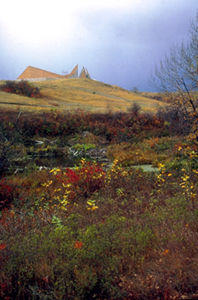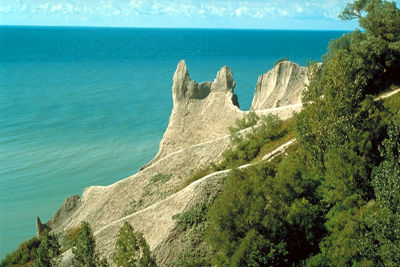Browse "Things"
-
Macleans
Lamaze Drug Case
This article was originally published in Maclean’s magazine on October 2, 2000. Partner content is not updated. Eric Lamaze walks into his Toronto lawyer's boardroom looking suntanned and refreshed. Amidst the onslaught of probing questions on his drug use and expulsion from the Canadian Olympic equestrian team, the 32-year-old rider speaks calmly - even as he rocks nervously in a chair.
"https://development.thecanadianencyclopedia.ca/images/tce_placeholder.jpg?v=e9dca980c9bdb3aa11e832e7ea94f5d9" // resources/views/front/categories/view.blade.php
https://development.thecanadianencyclopedia.ca/images/tce_placeholder.jpg?v=e9dca980c9bdb3aa11e832e7ea94f5d9
-
Article
Lambeosaurus
Lambeosaurus is a genus of large, plant-eating, duckbilled dinosaur. There are three known species of Lambeosaurus, all found in southern Alberta: L. clavinitialis, L. lambei and L. magnicristatus. In 1913, fossil collector Charles H. Sternberg discovered the first Lambeosaurus fossils in the modern-day Dinosaur Provincial Park area. A year later, Canadian paleontologist Lawrence Lambe named the fossils Stephanosaurus marginatus. Fellow Canadian William Parks then renamed the species Lambeosaurus lambei in 1923 in honour of Lambe. (See also Dinosaurs Found in Canada.)
"https://d2ttikhf7xbzbs.cloudfront.net/Lambeosaurus/Lambeosaurus1.jpg" // resources/views/front/categories/view.blade.php
https://d2ttikhf7xbzbs.cloudfront.net/Lambeosaurus/Lambeosaurus1.jpg
-
Article
Lamprey
Lamprey, group of primitive vertebrates which, together with hagfish and various extinct forms comprise the fish class Agnatha.
"https://d2ttikhf7xbzbs.cloudfront.net/media/media/31c5a075-649d-4cef-bc38-72753702d9cd.jpg" // resources/views/front/categories/view.blade.php
https://d2ttikhf7xbzbs.cloudfront.net/media/media/31c5a075-649d-4cef-bc38-72753702d9cd.jpg
-
Article
Land
Earth's surface experiences change driven by relief, sea level, hydroclimate and human activity. Extreme hydroclimatic events combined with human activity on steep slopes and/or adjacent to low-lying coasts generate natural hazards.
"https://d2ttikhf7xbzbs.cloudfront.net/media/media/da6ae2ec-e05e-46fd-916c-6185a6a86215.jpg" // resources/views/front/categories/view.blade.php
https://d2ttikhf7xbzbs.cloudfront.net/media/media/da6ae2ec-e05e-46fd-916c-6185a6a86215.jpg
-
Article
Land Acknowledgment
Land acknowledgements, also known as territorial acknowledgements, are short statements that recognize both the land and the Indigenous people who lived — and in many situations continue to live — on the land prior to Canada’s colonial history. They offer a short story from the stand point of the Indigenous people who grew and evolved from the land. Since the 2015 release of the Truth and Reconciliation Commission’s final report, land acknowledgements have become ubiquitous. In Canada, they are now offered before events, are common place on institutional websites, and are often found in people’s public profiles, social media biographies, and email signatures. In line with their relative newness, land acknowledgements have been subject to much discussion and critique. However, Indigenous people are not asking for their demise. Rather, they are seeking to make them more personal, heartfelt, and historically accurate — namely, more meaningful. Some people are also suggesting that they provide greater practical value for Indigenous communities, for example, in the form of Canada meaningfully sharing the resources the land and water provide. More provocatively, some Indigenous people are advocating that Canada give them their land back.
"https://d2ttikhf7xbzbs.cloudfront.net/LandAcknowledgement/ChaudiereFalls.jpg" // resources/views/front/categories/view.blade.php
https://d2ttikhf7xbzbs.cloudfront.net/LandAcknowledgement/ChaudiereFalls.jpg
-
Article
Land Cession
A land cession is a transfer of land from one party to another through a deed of sale or surrender. Land cessions may also be referred to as land surrenders and land purchases. In Canada and the United States, Indigenous land cessions generally took place through negotiated treaties. There are cases, however, where Indigenous peoples claim that lands were taken unjustly. The Royal Proclamation of 1763 established the protocols for land cession in both Canada and the United States.
"https://d2ttikhf7xbzbs.cloudfront.net/Indigenous treaties across Canada.jpg" // resources/views/front/categories/view.blade.php
https://d2ttikhf7xbzbs.cloudfront.net/Indigenous treaties across Canada.jpg
-
Article
Indigenous Land Claims in Canada
Land claims seek to address wrongs made against Indigenous peoples, their rights and lands, by the federal and provincial or territorial governments. There are different types of land claims. Comprehensive claims (also known as modern treaties) deal with Indigenous rights, while specific claims concern the government’s outstanding obligations under historic treaties or the Indian Act. There are many ongoing comprehensive and specific claims negotiations in Canada.
"https://d2ttikhf7xbzbs.cloudfront.net/media/media/174cee51-4aca-4a67-ac60-f72697d35862.jpg" // resources/views/front/categories/view.blade.php
https://d2ttikhf7xbzbs.cloudfront.net/media/media/174cee51-4aca-4a67-ac60-f72697d35862.jpg
-
Article
Land God Gave to Cain
The Land God Gave to Cain, was Jacques CARTIER's description of the north shore of the Gulf of St Lawrence, which he first sighted in 1534. Cartier was presumably alluding to Genesis 4, in which Cain, having killed his brother, is condemned to till land that is barren.
"https://development.thecanadianencyclopedia.ca/images/tce_placeholder.jpg?v=e9dca980c9bdb3aa11e832e7ea94f5d9" // resources/views/front/categories/view.blade.php
https://development.thecanadianencyclopedia.ca/images/tce_placeholder.jpg?v=e9dca980c9bdb3aa11e832e7ea94f5d9
-
Article
Canada and the Movement to Ban Land Mines
In the mid-1990s, Canada became a global leader in the effort to eradicate land mines, which are explosive and deadly weapons. In December 1997, representatives from 122 countries assembled in Ottawa to sign the Mine Ban Treaty (or Ottawa Treaty), which came into force on 1 March 1999. With over 80 per cent of the countries in the world having signed the treaty, it is one of the most widely accepted. The Canadian government continues to support demining efforts globally by assisting in related United Nations operations, supporting organizations like the International Campaign to Ban Landmines, and providing training, education and funding for mine clearing.
"https://d2ttikhf7xbzbs.cloudfront.net/media/media/5ba6f6d1-a6f0-443d-82ea-5da36705544a.jpg" // resources/views/front/categories/view.blade.php
https://d2ttikhf7xbzbs.cloudfront.net/media/media/5ba6f6d1-a6f0-443d-82ea-5da36705544a.jpg
-
"https://development.thecanadianencyclopedia.ca/images/tce_placeholder.jpg?v=e9dca980c9bdb3aa11e832e7ea94f5d9" // resources/views/front/categories/view.blade.php
https://development.thecanadianencyclopedia.ca/images/tce_placeholder.jpg?v=e9dca980c9bdb3aa11e832e7ea94f5d9
-
Article
Landlord and Tenant Law
Landlord and tenant law, governed by provincial statutes and judge-made law, varies considerably from province to province. Essentially, a landlord and tenant relationship is contractual (see CONTRACT LAW).
"https://development.thecanadianencyclopedia.ca/images/tce_placeholder.jpg?v=e9dca980c9bdb3aa11e832e7ea94f5d9" // resources/views/front/categories/view.blade.php
https://development.thecanadianencyclopedia.ca/images/tce_placeholder.jpg?v=e9dca980c9bdb3aa11e832e7ea94f5d9
-
Article
Landscape Architecture
Landscape architecture is the profession concerned with the design, planning, management, and conservation of the built environment. Landscape architects use their creative abilities in the arts and sciences to design outdoor places and systems of open spaces that are useful, imaginative, enjoyable, and environmentally appropriate. Whether working for groups or individuals, landscape architects seek ideas that generate better environments for living. They are concerned about the land's potentials and constraints, the heritage significance of the cultural landscape, the restoration and expansion of ecological communities, the character and function of vegetation, and the efficient and beautiful use of materials.
"https://d2ttikhf7xbzbs.cloudfront.net/media/media/d46f9696-5428-45a8-b9a7-c542c2ed1fc1.jpg" // resources/views/front/categories/view.blade.php
https://d2ttikhf7xbzbs.cloudfront.net/media/media/d46f9696-5428-45a8-b9a7-c542c2ed1fc1.jpg
-
Article
Landslide
A landslide is a downward and outward movement of a soil mass that formed part of a slope.
"https://d2ttikhf7xbzbs.cloudfront.net/media/media/aa619f1e-89b3-414d-9f9c-3a5c9c0b0097.jpg" // resources/views/front/categories/view.blade.php
https://d2ttikhf7xbzbs.cloudfront.net/media/media/aa619f1e-89b3-414d-9f9c-3a5c9c0b0097.jpg
-
Article
Language
Language is a form of communication. More specifically, language is a communication system based on human sounds. There are, however, other forms of communication systems based on touch, scent, movement, colour, gesture and even the electrical impulses that pass through computers.
"https://d2ttikhf7xbzbs.cloudfront.net/media/new_article_images/LanguageLangue/Language_Langue.jpg" // resources/views/front/categories/view.blade.php
https://d2ttikhf7xbzbs.cloudfront.net/media/new_article_images/LanguageLangue/Language_Langue.jpg
-
Macleans
Language Law Decision in Quebec
It began with equal French and English lettering on a store sign, escalated with a $75 fine under Quebec's language laws - and ended with a court victory for Gwen Simpson and Wally Hoffmann.This article was originally published in Maclean's Magazine on November 1, 1999
"https://development.thecanadianencyclopedia.ca/images/tce_placeholder.jpg?v=e9dca980c9bdb3aa11e832e7ea94f5d9" // resources/views/front/categories/view.blade.php
https://development.thecanadianencyclopedia.ca/images/tce_placeholder.jpg?v=e9dca980c9bdb3aa11e832e7ea94f5d9
